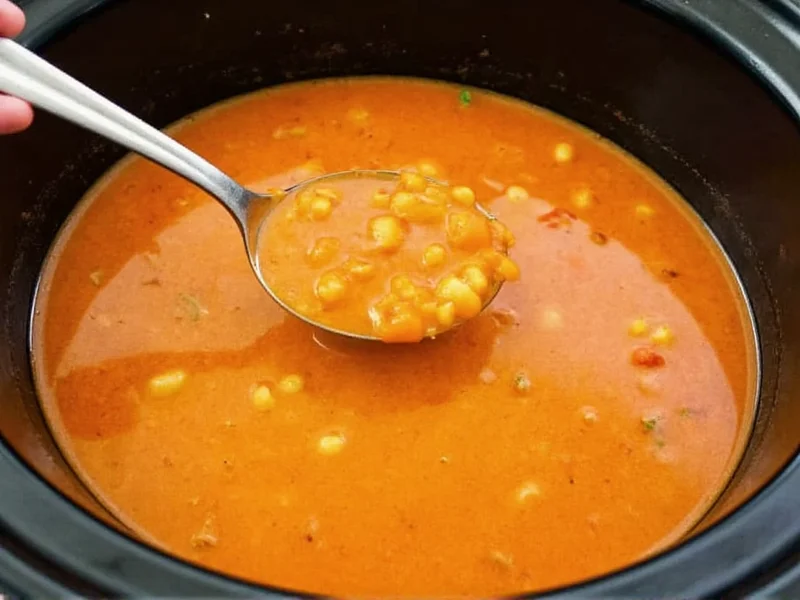The Ultimate Guide to Perfect Slow Cooker Soup
Slow cooker soup represents one of the most practical and flavorful approaches to home cooking. Unlike stovetop methods that demand constant attention, slow cooking transforms humble ingredients into complex, restaurant-quality soups with minimal effort. The magic happens through low-temperature cooking that extracts maximum flavor while preserving nutrients.
Why Slow Cooker Soup Outperforms Traditional Methods
Slow cooker soup preparation offers distinct advantages over conventional cooking techniques. The consistent, low heat environment prevents scorching while allowing flavors to meld gradually. This method particularly benefits tough cuts of meat, which become fork-tender through collagen breakdown. Vegetable fibers soften without disintegrating, maintaining desirable texture throughout the cooking process.
Energy efficiency stands as another significant benefit. A typical slow cooker uses about the same electricity as a standard light bulb, making it substantially more economical than maintaining a simmer on your stove for hours. The sealed environment also traps moisture, eliminating the need for frequent liquid adjustments that often plague stovetop soup preparation.
Essential Equipment for Slow Cooker Soup Success
| Equipment | Recommended Size | Key Benefits |
|---|---|---|
| Slow Cooker | 5-7 quart | Accommodates standard soup recipes without overflow |
| Immersion Blender | N/A | Creates creamy textures without transferring hot liquid |
| Slotted Spoon | Medium | Removes solids while retaining broth |
| Thermometer | Digital instant-read | Verifies safe internal temperatures for meat-containing soups |
While basic slow cookers work well for most applications, models with programmable timers and automatic warming functions provide additional convenience. These features prevent overcooking when you can't monitor the exact finish time. Regardless of model, always fill your slow cooker between one-half and three-quarters full for optimal heat distribution and flavor development.
Step-by-Step Slow Cooker Soup Preparation
Follow this professional technique for consistently excellent results:
- Brown meats first - Sear meats in a skillet before adding to the slow cooker for enhanced flavor through the Maillard reaction
- Sauté aromatics separately - Cook onions, garlic, and celery until softened to deepen flavor complexity
- Add liquids gradually - Pour broth slowly while scraping the skillet to incorporate flavorful fond
- Layer ingredients strategically - Place dense vegetables at the bottom, delicate ingredients near the top
- Control cooking time precisely - Most soups require 6-8 hours on low or 3-4 hours on high
- Finish with fresh elements - Add dairy, pasta, or delicate greens during the final 30-60 minutes
This method ensures proper flavor layering while maintaining ideal texture throughout the soup. Many home cooks make the mistake of dumping everything in raw, which results in muted flavors and inconsistent textures.
Avoiding Common Slow Cooker Soup Mistakes
Even experienced cooks encounter pitfalls when preparing slow cooker soup. Understanding these common errors prevents disappointing results:
- Overfilling the slow cooker - Exceeding three-quarters capacity causes uneven cooking and potential overflow
- Adding dairy too early - Dairy products curdle when exposed to prolonged heat; add during final 30 minutes
- Ignoring layering principles - Dense vegetables like potatoes need bottom placement for thorough cooking
- Skipping the browning step - Raw meats produce less flavorful results compared to seared alternatives
- Overseasoning initially - Flavors concentrate during cooking; season gradually throughout the process
Professional chefs recommend tasting and adjusting seasoning during the final hour of cooking, as flavors continue developing until the moment you serve.
Popular Slow Cooker Soup Variations
Explore these versatile slow cooker soup options that accommodate various dietary preferences:
- Classic Chicken Noodle - Use bone-in chicken for superior flavor, adding noodles during the last hour
- Hearty Beef Stew - Combine chuck roast with root vegetables for a satisfying cold-weather meal
- Vegetarian Minestrone - Packed with seasonal vegetables and cannellini beans for protein
- Creamy Tomato Basil - Use fire-roasted tomatoes and fresh basil for vibrant flavor
- Spicy Black Bean - Add lime juice and cilantro at serving for bright contrast
For gluten-free options, replace traditional thickeners with pureed vegetables or gluten-free grains. Many slow cooker soups actually improve when made ahead, as flavors continue melding during refrigeration.
Storage and Reheating Best Practices
Proper storage extends your slow cooker soup's shelf life while maintaining quality:
- Cool soup completely before refrigerating to prevent condensation
- Store in airtight containers for up to 4 days in the refrigerator
- Freeze in portion-sized containers for up to 3 months
- Reheat gently on stove or in microwave, adding liquid if needed
- Never repeatedly reheat the same portion to maintain food safety
When reheating frozen soup, thaw overnight in the refrigerator rather than using microwave defrost settings, which can cause uneven heating and texture changes in dairy-based soups.
Troubleshooting Common Issues
Address these frequent slow cooker soup challenges with professional solutions:
- Soup too thin - Create a slurry with cornstarch and cold water, stirring in during final 30 minutes
- Soup too thick - Gradually add additional broth or water until desired consistency achieved
- Bland flavor - Add acid (lemon juice or vinegar) to brighten flavors without additional salt
- Vegetables overcooked - Cut dense vegetables larger or add during final 2 hours
- Fat accumulation - Chill soup briefly to solidify fat for easy removal
Remember that slow cooker temperatures vary between models. If your soups consistently finish too early or late, adjust cooking times accordingly while monitoring internal temperatures.
Final Thoughts on Slow Cooker Soup Mastery
Mastering slow cooker soup preparation transforms weeknight cooking into a stress-free experience. The key lies in understanding ingredient behavior during prolonged cooking and adjusting techniques accordingly. By following these evidence-based methods, you'll consistently produce restaurant-quality soups with minimal effort. Whether you're preparing healthy slow cooker soup options for meal prep or crafting special occasion dishes, this versatile appliance delivers exceptional results when used correctly.











 浙公网安备
33010002000092号
浙公网安备
33010002000092号 浙B2-20120091-4
浙B2-20120091-4